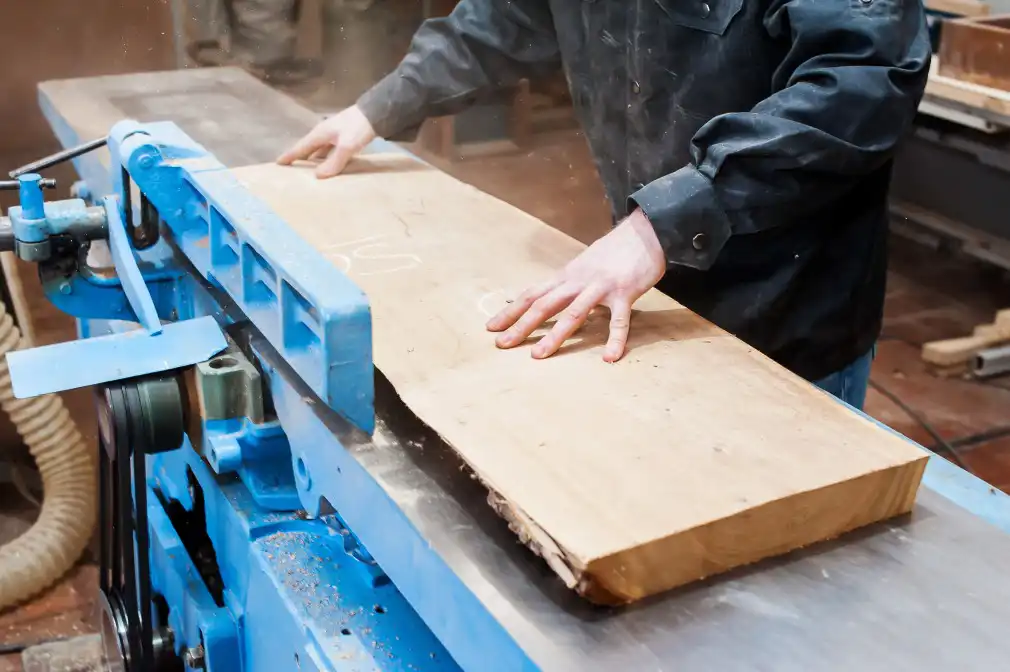Belt Sander Overview
The belt sander is a small handheld belt sander or a larger tabletop belt sander that features a powerful motor. The 10 amp motor works on heavy projects. The belt sander has a large belt or strap set in a loop.
The belt moves in one continuous motion, moving in a circle at high speeds. It runs up to 3,000 surface feet per minute. The belt has sandpaper designed to remove small amounts of wood, even out surfaces, paint, varnish, and smooth surfaces.
Belt sanders are for smoothing and evening things out because they can handle sandpaper of very coarse grit. That is how you get a high rate of wood removal. They sand both with and against the grain.

Pros
- Durability and high-grade engineering
- Ergonomically designed
- Velocity control technology
- Ease of changing sanding pads
- Optimal efficiency
- Compatible with most wide paper grits.
- Sound level reduction
- Adjustable dust bag
Cons
- Not affordable
- No variable speed management
Planer Overview
Planers come in all sizes, including full cabinet size planers, smaller benchtop planers, and smaller handheld planers. The wood planer has the form of a wooden block with a blade for shaving layers off of wooden boards. Its purpose is to create a flat, smooth, and uniform layer. Modern planers are also handheld, although they do not use motors.
They use manual power. The larger tabletop models are accurate due to an included planning platform for fast and thickness adjustments. When you think of a planer, you have a larger tabletop or cabinet model, featuring a table that the wood rests on.
Planers feature drums or small barrels outfitted with blades or knives that spin at high speeds. Some small wheels or rollers pull the wood over the platform and through the blades. As the wood passes by the planer blades, wood is removed from one side to the other, resulting in a flat and symmetrical board from front to back.

Pros
- Premium-quality head cutter
- Cuts through wide materials
- Replacement knives.
- Smooth
- Cost-effective
- Uniformity
- Effective
- Comfortable
Cons
- Makes noise
- High experience is needed
Differences Between Belt Sanders and Planers
- The difference between these two woodworking tools is that a belt sander uses sandpaper to sand away at the surface of wood, whereas planers use large blades to cut away at any depth of your choice.
- With planers, some rollers pull the wood through the blades. You have to hold the wood steady, and the planer does the rest of the work.
- Belt sanders do not have rollers that pull the wood through the machine. Always move the sander over the wood.
- The two tools differ in their intended purpose. A planer is there to even out and flatten wood to create a uniform surface. If you have a warped piece of wood, you could set the planer to cut away the warp for a squared and symmetrical piece of wood. That is flatness and evenness. Keep in mind that planers are for long and flat boards.
- Belt sanders are for smoothing out surfaces, evening out new additions, creating curves and shapes on nearly finished wood products, smoothing out rough edges, removing imperfections from wood surfaces, and removing paint, stain, and lacquer from wooden surfaces.
- Planers create one single even, and flat surface from one end of the piece of wood to the other, whereas a sander cannot do this. A sander is manual, and it is hard to sand away the same amount of wood along with a four-foot board.
- Tabletop planers have depth guides that you can set to specific levels so that the machine cuts away wood. You cannot do this with a belt sander as you have to keep measuring the piece of wood as you go and keep estimating how much material has been removed.
- Planers remove chips or long strips of wood, whereas belt sanders create sawdust that flies into the air. Belt sanders create a much bigger mess than planers do.
- The other difference is that planers can cut into wood deep, whereas sanders remove material from the top surface.
When to use a belt sander instead of a planer
If you want to create curves, smooth out a surface, remove rough edges, prepare a surface for painting, or even out a small surface, you need a belt sander.
When to use a planer instead of a belt sander
If you need to even out a longboard, that is warped or not straight and flat, it is a planer that you need to use.
Price comparison
Planers tend to cost less than wide belt sanders. Planers can also be cheaper to maintain without regularly buying supplies like sanding belts. Some smaller shops can go for a planner as a w to save money. Remember that these tools are different. There are jobs where a wide belt sander makes more sense and can be worth the investment.
Belt sander or planer for doors?
Planers tend to remove chips or long strips of wood, whereas belt sanders create more sawdust that flies into the air. Belt sanders create a much bigger mess than planers do. The coarse texture of the belt removes wood quickly and gives you an even finish. You can use an electric planer, but belt sanders are affordable. The biggest benefit a Planer has over a belt sander is that it makes it simpler to create straight and uniform cuts.
Wide belt sander vs planer
Wide belt sanders use an abrasive belt to sand surfaces, while planers have blades. Each machine delivers a smoother surface, but that means, their use is different. Both wide belt sanders and planers are quality woodworking machines. Choose one depending on your application. If you need to even out a long wooden board, a planer is fast.
If you want to strip away coatings or make a surface smoother, the belt sander performs better. The wide belt sander is used to machine stock flat and specific thicknesses (Edusites). Planer is a machine tool used for producing accurate flat surfaces and cutting slots (Mechanicalbooster.com).
- Grain and Sheen: Teak Oil versus Danish Oil Uncovered - January 10, 2024
- The Cherry on Top: Crafting the Perfect Cutting Board - January 9, 2024
- Polyurethane Water-Based vs Oil-Based: Choosing the Right Finish - January 8, 2024